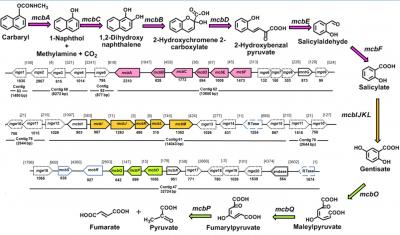
Carbaryl is widely used as a pesticide in the agricultural field since 1958. Apart from the desired effects, the toxicity of carbaryl to beneficial organisms like bees, earthworm and marine fishes is a cause of concern. Its extensive usage has led to environmental pollution. Within a decade of carbaryl application in the agricultural field,many microorganisms with ability to degrade it were isolated. Pseudomonas sp. isolated from soil in our lab converts carbaryl into cell biomass via. 1-naphthol, salicylate, gentisate to TCA cycle intermediates by utilising it as a sole source of carbon and energy.
Genome analysis reveals that this ability has evolved in the must have been acquired by gene-exchange and has underwent evolutionary changes to make the process efficient. This study helps to understand the molecular mechanisms involved in the assembly and evolution of metabolic pathway for recently introduced compound like carbaryl in the environment. As the pathway has been observed to be segmented and are independently controlled, genetic engineering tools can be employed to construct a single chassis strain which will be effective against array of aromatic compounds. As a proof-of-concept,E. coli when transformed with one such segment could utilise gentisateand convert it into biomass. The strain also carries genes involved in nitrogen metabolism and suggests that carbaryl can also be utilised as a source of nitrogen. Therefore, bioremediation of carbaryl is possible even in the nitrogen deficient soils. This property makes this strain capable of removing carbaryl completely from the contaminated sites. We have also isolated a Pseudomonas strain C7 which can perform the activity of remediating carbaryl in the presence of varying concentration of salt. Though with the increasing concentration of salt, the growth of the bacteria is slowed, nevertheless, carbaryl is completely degraded. This strain can be introduced in the saline inflicted ecosystems contaminated with carbaryl.
Prof. P S Phale
